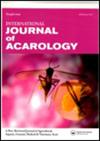Interaction of spirodiclofen, fenpyroximate, etoxazole, and imidacloprid for the control of two-spotted spider mite, Tetranychus urticae Koch
IF 1
3区 农林科学
Q3 ENTOMOLOGY
引用次数: 0
Abstract
ABSTRACT The interaction relationships of a binary mixture of spirodiclofen, fenpyroximate, and etoxazole acaricides, and mixing each of these acaricides with imidacloprid were investigated on deutonymph of Tetranychus urticae using the Potter spray tower method under controlled laboratory conditions. Based on the results of bioassay tests and combination index (CI) estimates, the toxicity of the binary mixture of the tested acaricides with each other and with imidacloprid on T. urticae was lower than that of each compound alone, and the interaction of their binary mixture was the antagonistic type. The measurement of the activity level of detoxifying enzymes in T. urticae treated with the LC50 concentration of pesticides and their binary mixture showed that the highest α- and β-esterase and glutathione S-transferase (GST) activities were observed in mites treated with spirodiclofen. Additionally, the highest cytochrome P450 monooxygenases (MFO) content was detected in mites treated with a mixture of spirodiclofen and imidacloprid. The results indicated that the application of a binary mixture of the mentioned acaricides together and in combination with imidacloprid leads to inefficient control of T. urticae.吡虫啉、苯吡肟、乙恶唑与吡虫啉互作防治荨麻疹叶螨的研究
摘要在实验室条件下,采用波特喷雾塔法,研究了吡虫啉、苯吡肟和乙恶唑三种杀螨剂的二元混合物,以及每种杀螨剂与吡虫啉混合对荨麻疹叶螨的相互作用关系。生物测定试验和联合指数(CI)估算结果表明,所试杀螨剂相互及与吡虫啉二元混剂对荨麻疹螨的毒力均低于单用,且两者二元混剂的相互作用为拮抗型。对LC50浓度农药及其混合物处理的荨麻疹螨解毒酶活性测定表明,螺双氯芬处理的α-和β-酯酶和谷胱甘肽s -转移酶(GST)活性最高。此外,吡虫啉与螺双氯芬混合处理的螨体细胞色素P450单加氧酶(MFO)含量最高。结果表明,上述药剂与吡虫啉混用或与吡虫啉混用对荨麻疹螨的防治效果较差。
本文章由计算机程序翻译,如有差异,请以英文原文为准。
求助全文
约1分钟内获得全文
求助全文
来源期刊
CiteScore
2.20
自引率
9.10%
发文量
60
审稿时长
6-12 weeks
期刊介绍:
The International Journal of Acarology has a global readership and publishes original research and review papers on a wide variety of acarological subjects including:
• mite and tick behavior
• biochemistry
• biology
• control
• ecology
• evolution
• morphology
• physiology
• systematics
• taxonomy (single species descriptions are discouraged unless accompanied by additional new information on ecology, biology, systematics, etc.)
All submitted manuscripts are subject to initial appraisal by the Editor. If the English is not of a quality suitable for reviewers, the manuscript will be returned. If found suitable for further consideration, it will be submitted to peer review by independent, anonymous expert referees. All peer review is single blind.

 求助内容:
求助内容: 应助结果提醒方式:
应助结果提醒方式:


